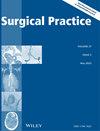二头肌远端肌腱断裂:临床特征,诊断策略和治疗方案
IF 0.3
4区 医学
Q4 SURGERY
引用次数: 0
摘要
的相关性。本文综述了有关肱二头肌远端肌腱修复的最新证据,特别是撕裂类型,患者人口统计学,诊断线索,手术指征,远端肌腱止点解剖,桡骨结节,单切口与双切口重建,固定技术(骨隧道,肱二头肌远端螺钉,干涉螺钉,螺钉加螺钉)和术后结果等方面。材料和方法。使用关键词“远端肱二头肌肌腱”、“肘部”、“髓内”、“局部”搜索MEDLINE、Cochrane、Web of Science、Scopus和library在线数据库。' complete ', ' review '和' rupture '。在1951年至2021年10月的60年间,我们发现了60篇关于肱二头肌腱远端断裂治疗的出版物。结果和讨论。本综述表明,完全性三角韧带(DBT)撕裂主要是临床诊断,而医学影像学已被证明是诊断部分撕裂的有价值的辅助手段。部分撕裂的临床和医学成像的进步有可能加快诊断过程和指导治疗策略。一期修复通常用于完全性撕裂,采用单切口或双切口方法,可获得良好的临床结果。然而,双切口技术具有较高的异位骨化风险,而单切口入路具有更大的神经相关并发症风险。为了减轻单切口修复中后路骨间神经损伤的风险,髓内固定可能是一种可行的解决方案。此外,DBT内窥镜有希望治疗低级别部分撕裂和肌腱病。本文章由计算机程序翻译,如有差异,请以英文原文为准。
Distal biceps tendon ruptures: clinical features, diagnostic strategy and treatment options
Relevance. This paper reviews the latest evidence concerning distal biceps tendon repair, particularly aspects such as tear type, patient demographics, diagnostic clues, surgical indications, the anatomy of distal tendon insertion, radial tuberosity, single- vs double-incision reconstruction, fixation techniques (bone tunnels, distal biceps button, interference screw, button plus screw) and postoperative outcomes.Material and methods. The MEDLINE, Cochrane, Web of Science, Scopus and Elibrary online databases were searched using the keywords ‘distal biceps tendon’, ‘elbow’, ‘intramedullary’, ‘partial’. ‘complete’, ‘review’ and ‘rupture’. Sixty publications on distal biceps tendon rupture treatment were identified that appeared over 60 years, between 1951 and October 2021.Results and discussion. The review has demonstrated that complete deltoid ligament (DBT) tears are predominantly diagnosed clinically, while medical imaging has proven to be a valuable adjunct for diagnosing partial tears. Advances in clinical and medical imaging of partial tears have the potential to expedite the diagnostic process and guide treatment strategies. Primary repair is commonly employed for complete tears, utilizing either a single-incision or double-incision approach, resulting in favorable clinical outcomes. However, the double-incision technique carries a higher risk of heterotopic ossification, whereas the single-incision approach presents a greater risk of nerve-related complications. To mitigate the risk of posterior interosseous nerve lesions in single-incision repairs, intramedullary fixation may serve as a viable solution. Additionally, DBT endoscopy holds promise for the treatment of low-grade partial tears and tendinosis.
求助全文
通过发布文献求助,成功后即可免费获取论文全文。
去求助
来源期刊

Surgical Practice
医学-外科
CiteScore
0.90
自引率
0.00%
发文量
74
审稿时长
>12 weeks
期刊介绍:
Surgical Practice is a peer-reviewed quarterly journal, which is dedicated to the art and science of advances in clinical practice and research in surgery. Surgical Practice publishes papers in all fields of surgery and surgery-related disciplines. It consists of sections of history, leading articles, reviews, original papers, discussion papers, education, case reports, short notes on surgical techniques and letters to the Editor.
 求助内容:
求助内容: 应助结果提醒方式:
应助结果提醒方式:


